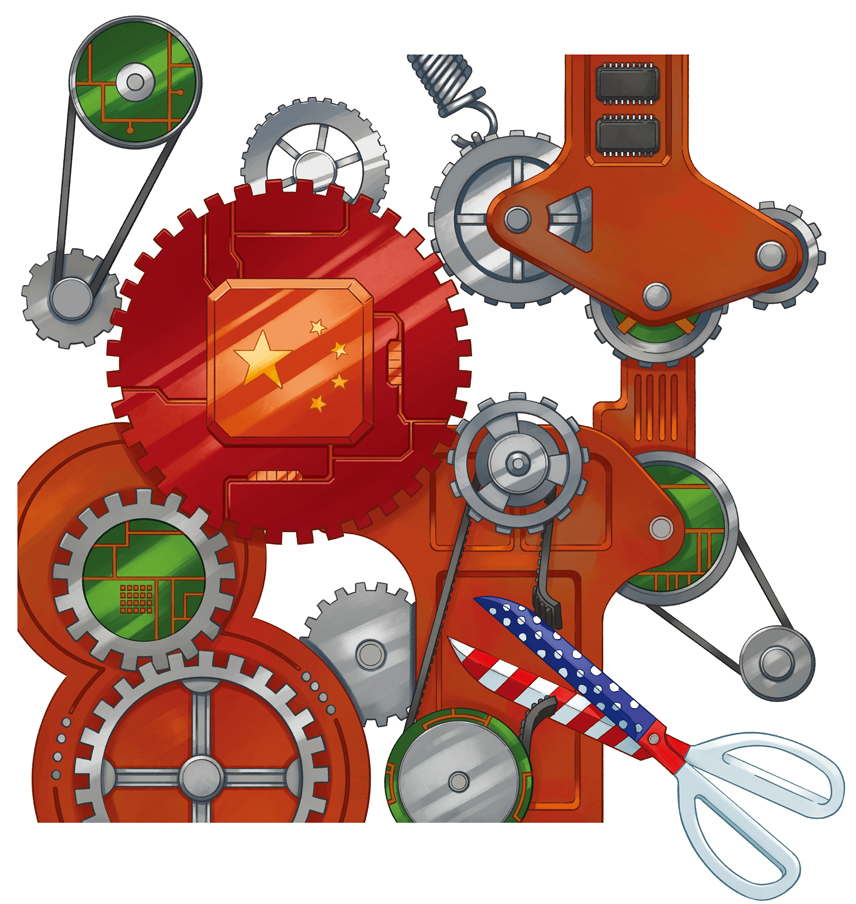Around the world, the October death of Apple co-founder Steve Jobs was a collective moment of mourning, admiration, and reflection. In China, another element was added to the mix: self-flagellation. Why, lamented many commentators, has China failed to produce its own Steve Jobs?
Former Google China chief Kai-Fu Lee, writing on Sina Weibo, blamed an educational system that prioritizes rote memorization over creative thinking. Investment strategist Qiu Lin argued in Caixin that government support of state- owned enterprises over private businesses discourages innovation. Independent scholar Wu Jiaxiang put the blame squarely on China’s political system. “If Apple is a fruit on a tree,” he wrote on his microblog account, “its branches are the freedom to think and create, and its root is constitutional democracy.”
The reaction to Jobs’ death underscores an aspect of China’s rapid economic growth that sometimes gets lost in all the hype about dragons awakening and red stars rising. That is, while China manufactures a huge number of products each year, the ideas for the products are conceived–and the profits mostly accrue–outside China. Indeed, China’s 10 percent annual GDP growth is largely attributable to manufacturing capacity, rather than original product conception and design. It’s one thing for so many smart new gizmos to be “Made in China,” but why are they so rarely invented here?
President Hu Jintao acknowledged this quandary back in 2006 when he laid out a 15-year plan to make China an “innovation-oriented society,” promising to foster “indigenous innovation” by nearly doubling research and development expenditures as a percentage of GDP. This plan was motivated by more than just nationalism; China’s economic future depends on it. “Low-cost manufacturing has seen its best days already,” says Cheung Kong Graduate School of Business (CKGSB) Associate Dean and Professor of Strategic Management Teng Bingsheng. With the price of labor and raw materials rising, Chinese companies are being forced to adapt. For most firms, that means moving up the value chain from manufacturing to R&D, design, and branding.
Examples of companies that are successfully making this transition abound. Large companies like mobile communications giant Huawei have prioritized R&D and are starting to see results. Having faced accusations of copying early last decade, Huawei later produced genuine innovations in 3G, such as wireless base stations that could be installed quickly and cheaply. Although the microblogging service Sina Weibo launched after Twitter, it was first to integrate threaded conversations and photo and video features. The LED maker Lattice Power has produced original high-powered light bulb technology. Recognizing the potential for profit, foreign venture capital firms have sunk money into Chinese start-ups and, in 2010, Chinese government investment helped finance the world’s fastest supercomputer. (A Japanese machine soon surpassed it.)
Another recent government plan calls for two million patents to be filed by 2015, a goal that appears achievable. According to a 2010 report by Thompson Reuters, China was on track to become the world’s top patent-filer in 2011. (The final data is still pending.) But explosive numbers like these can be deceptive. Of the 203,481 patent applications filed by Chinese organizations in 2008, only 473 were recognized by all three leading patent offices in the United States., the European Union, and Japan. (This compares to 14,399 patents approved out of 400,769 filed from the United States and 13,446 out of 502,054 from Japan that same year.) A 2011 Thompson Reuters list of the 100 most innovative companies in the world did not include a single Chinese firm.
Some analysts are skeptical of China’s innovation potential. “If you go back 20 years, nobody cared a damn about what was happening in China,” says Anil Gupta, a professor of strategy and entrepreneurship at the University of Maryland who co-authored a book on economic growth in China and India. “The innovation level was zero. So now when it wakes up and starts walking, people say, ‘Wow, I thought you were dead.'”
There are many kinds of innovation, however, and China may simply not excel at the sort of radical, new- product innovation that overhauls industries and draws media attention. “By and large, I don’t think it’s a culture of great non-incremental change,” says Richard P. Suttmeier, professor emeritus of political science at the University of Oregon, who testified before the U.S. Congressional- Executive Commission on China in 2010 on the subject of innovation and intellectual property in China. Instead, China specializes in localization, which adapts existing technologies for a local market; incremental innovation, which improves a product’s cost or time-to-market without drastically changing the technology; and process innovation, which adjusts the manufacturing and supply processes to make them more efficient.
That’s why Chinese innovation is often described as “renovation,” meaning that a company borrows the technology or business model of a successful Western company and adjusts it to suit the Chinese market. A prominent example of this practice is Xiaomi, which last summer launched a high- end smartphone that runs Android software and sells at less than half the price of an iPhone. Imitating leading brands at lower prices is a good strategy–for now. “The big question for the Chinese is, how do you go beyond catch-up?” says Suttmeier.
While there’s no single answer, a range of experts on Chinese technology and innovation argue that China needs to take several steps if it’s going to become a truly “innovation- oriented society.” These include:
Improve the research environment.
In 2010, professors Yigong Shi and Rao Yi, both of whom returned to Beijing from prestigious academic jobs in the United States, published an editorial in the journal Science criticizing Chinese research culture. “It is an open secret
that doing good research is not as important as schmoozing with powerful bureaucrats and their favorite experts,” they wrote. “China’s current research culture … wastes resources, corrupts the spirit, and stymies innovation.” Many Chinese universities also offer professors perverse incentives by rewarding them based on how often they publish. The result is shoddy research, plagiarism, and outright fraud. A 2008 study found that 31 percent of scientific papers in China included copying or plagiarism.
Curb the “great leap” mentality.
Technological “leap-frogging”–a country using its relative lack of infrastructure to jump ahead of the competition– can benefit developing economies. But it can also backfire, especially when it involves excessive speed, inadequate testing, and other means of cutting corners. For example, investigations of the July train crash in Wenzhou cited an overzealous competitive drive as a contributing factor. “If you just do it top-down without consideration for social costs and tremendous risks, then you end up actually slowing down the process rather than speeding it up,” says Dieter Ernst, a senior fellow at the East-West Center and former senior advisor to the Organization for Economic Cooperation and Development.
Clean up the patent system.
An incentives structure similar to that of academic publishing leads professors to apply for–and governments to approve– patents that lack merit. In 2009, about half of China’s patent applications were for so-called “utility” patents, which, unlike “invention” patents, don’t require official inspection and last only 10 years instead of 20. Just as researchers are rewarded for the number of applications they file, patent examiners in state intellectual property offices receive bonuses based on the number of patents they approve. “It’s like giving teachers bonuses for how many kids they pass,” says Gupta. As a result, the vast majority of patents approved in China don’t pass muster in the United States and Europe.
Encourage cross-departmental collaboration.
The number of colleges in China has doubled since 1998, and the number of students has increased more than fourfold. While this is largely good news–more Chinese people are receiving higher education–it has also strained student- teacher ratios and stretched university resources. “That speedy expansion almost by definition will raise quality problems,” says Ernst. Another concern is the process by which students are siphoned into professional fields early on. “A lot of innovation comes from people who cross boundaries,” says Willy Shih, a professor of management practice at Harvard Business School who has published extensively on innovation in China. Allowing students more choice in their studies and encouraging professors in different disciplines to work together will spur innovation.
Eliminate “structured uncertainty.”
The Chinese business environment is characterized by what Georgia Institute of Technology Professor Dan Breznitz calls “structured uncertainty.” In their new book, Run of the Red Queen: Government, Innovation, Globalization, and Economic Growth in China (Yale University Press), Breznitz and co- author Michael Murphree argue that Chinese laws are deliberately ambiguous, leaving local officials to interpret and implement them however they want. Uncertainty is the opposite of what businesses want and need. When tax rates shift unpredictably and entire industries fall in and out of government favor, investors have less incentive to bet on risky ventures with distant payoffs. “The whole system is tilted against taking risks with money over long periods of time,” says Breznitz.
Reduce interagency rivalries. Bureaucratic competition and overlapping jurisdictions compound problems of uncertainty. For example, the Ministry of Industry and Information Technology has clashed with the State Administration of Radio, Film and Television over which agency is responsible for security standards and certification in mobile communications, according to Ernst. The result is not just unclear standards, but confusion about who even has the right to set them.
Strengthen intellectual property rights.
When the movie Kung Fu Panda broke Chinese box office records in 2008, Chinese commentators rued Hollywood’s “selling back” of Chinese culture to China. While some blamed government restrictions on the content of domestic animated films, Shih says intellectual property also plays a role: “The property rights environment for that type of creative property is very weak. Where’s the incentive there?” Likewise, China has yet to produce a software giant like Microsoft or Adobe, in part because would-be entrepreneurs know that no one would realistically pay for such products. China’s IP policy can be viewed as a classic chicken- and-egg problem. It has no Microsoft because IP rights are weak–or perhaps IP rights are weak because it has no Microsoft. Once Chinese businesses start creating valuable property and demanding protection for it, China will start enforcing property rights. Until then, companies will have to innovate their way around weak IP enforcement, says Andy Mok, CEO of Red Pagoda Resources, a Beijing firm that helps start-ups recruit talent. For example, video game companies offer free mobile apps that sell virtual goods and musical acts focus more on live performances than record sales.
Support failure.
The self-help books don’t lie: failure is key to success. When nine out of ten startups are doomed to fail, investors and entrepreneurs must be willing to take risks. Researchers, too, must feel confident conducting experiments that might not succeed–which of course describes any experiment worth doing. In China, failure is often penalized. In 2007, China passed a law that would allow scientists to report failures without having their funding pulled, as long as they can show they did their best. The same forgiving attitude should apply to R&D in the business world. “The essence of innovation is to tolerate failure,” said Xiaomi CEO Lei Jun at a recent Beijing conference organized by Entrepreneur magazine. “Only if we have an environment that tolerates failure can Chinese society and industry advance.”
China of course isn’t the only manufacturing economy that has tried to boost innovation. Japan, Korea, Taiwan– just about every other advanced economy in Asia has gone through the same process of reinvention. Ultimately, the question isn’t whether China will become a more innovative economy, so much as when. “It’s going to take a generation,” says Rebecca Fannin, a Forbes contributor and author of Startup Asia: Top Strategies for Cashing in on Asia’s Innovation Boom (Wiley).
When China does become an innovation hub, odds are it won’t look like Silicon Valley, the I-95 corridor, or North Carolina’s Research Triangle. Instead , it will build on China’s existing competitive advantage in manufacturing and make small but critical changes to things like the white power cord that plugs into any Apple laptop. “Not that many years ago, they had a tendency to get hot and burn like batteries,” says Breznitz. But thanks to constant tweaking of the technology and design–in China, not California–the power cords have improved. Breznitz and Murphree argue that China should focus on this kind of innovation–incremental, manufacturing- based, often subtle to consumers.
Fannin believes the day will come when China finally does produce a Jobs-caliber entrepreneur. “If you look at Chinese entrepreneurs’ personalities, there are a lot of Steve Jobs-like characteristics. There’s a lot more confidence today,” she says. It helps that Chinese entrepreneurs can now look up to home-grown heroes, like Alibaba’s Jack Ma and Baidu’s Robin Li. “They did it,” Fannin suggests budding entrepreneurs might ask themselves, “Why can’t I?”
















